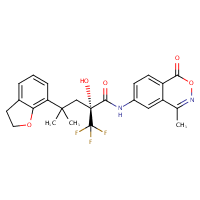| Reference | 1. Bioorg Med Chem Lett. 2010 Oct 1;20(19):5835-8. doi: 10.1016/j.bmcl.2010.07.125. Epub 2010 Aug 3.<br />
Discovery of quinolines as selective glucocorticoid receptor agonists.<br />
Jaroch S(1), Berger M, Huwe C, Krolikiewicz K, Rehwinkel H, Schäcke H, Schmees N, Skuballa W.<br />
Author information:<br />
(1)Medicinal Chemistry Berlin, Lead Generation & Optimization, Bayer Schering Pharma AG, Berlin D-13342, Germany. [email protected]<br />
The dissociated glucocorticoid receptor (GR) agonist ZK 216348 is rendered GR-selective over other nuclear hormone receptors through replacing the methylbenzoxazine with a quinoline moiety. Compounds were shown to be efficacious in cell assays with respect to inflammation endpoints, along with reduced activity in a transactivation assay, hinting at an improved therapeutic window over corticosteroids.<br />
<br />
2. Proc Natl Acad Sci U S A. 2004 Jan 6;101(1):227-32. Epub 2003 Dec 23.<br />
Dissociation of transactivation from transrepression by a selective glucocorticoid receptor agonist leads to separation of therapeutic effects from side effects.<br />
Schäcke H(1), Schottelius A, Döcke WD, Strehlke P, Jaroch S, Schmees N, Rehwinkel H, Hennekes H, Asadullah K.<br />
Author information:<br />
(1)Corporate Research Business Area Dermatology, Corporate Project Management Strategic Business Unit Specialized Therapeutics, and Medicinal Chemistry, Schering AG, Berlin, D-13342 Berlin, Germany. [email protected]<br />
Glucocorticoids (GCs) are the most commonly used antiinflammatory and immunosuppressive drugs. Their outstanding therapeutic effects, however, are often accompanied by severe and sometimes irreversible side effects. For this reason, one goal of research in the GC field is the development of new drugs, which show a reduced side-effect profile while maintaining the antiinflammatory and immunosuppressive properties of classical GCs. GCs affect gene expression by both transactivation and transrepression mechanisms. The antiinflammatory effects are mediated to a major extent via transrepression, while many side effects are due to transactivation. Our aim has been to identify ligands of the GC receptor (GR), which preferentially induce transrepression with little or no transactivating activity. Here we describe a nonsteroidal selective GR-agonist, ZK 216348, which shows a significant dissociation between transrepression and transactivation both in vitro and in vivo. In a murine model of skin inflammation, ZK 216348 showed antiinflammatory activity comparable to prednisolone for both systemic and topical application. A markedly superior side-effect profile was found with regard to increases in blood glucose, spleen involution, and, to a lesser extent, skin atrophy; however, adrenocorticotropic hormone suppression was similar for both compounds. Based on these findings, ZK 216348 should have a lower risk, e.g., for induction of diabetes mellitus. The selective GR agonists therefore represent a promising previously undescribed class of drug candidates with an improved therapeutic index compared to classical GCs. Moreover, they are useful tool compounds for further investigating the mechanisms of GR-mediated effects.<br />
|

